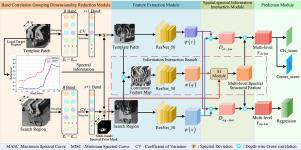SiamBSI: Hyperspectral video tracker based on band correlation grouping and spatial–spectral information interaction
IF 3.4
3区 物理与天体物理
Q2 INSTRUMENTS & INSTRUMENTATION
引用次数: 0
Abstract
This paper proposes an innovative hyperspectral video tracking method with band correlation grouping and spatial–spectral information interaction, termed SiamBSI. The purpose is to address the insufficient information interaction between the template and search branches in Siamese network-based tracking, as well as the limited discriminative capability of existing hyperspectral image dimensionality reduction methods. The method consists of three components. First, a novel dimensionality reduction method is introduced, which groups and reduces hyperspectral images based on band correlation and spectral deviation, while generating a multi-band spectral prior mask during the reduction process. Second, to enhance the information interaction between the template and search branches of the Siamese network, an additional information interaction branch is designed. Unlike conventional approaches, this branch first performs feature correlation between the local target region in the template image and the search region, and then extracts features from the correlated results. This branch incorporates a spatial–spectral information interaction (SI) module, which integrates spatial structural features (such as edge and texture features) with deep features, effectively addressing challenges such as background clutter and scale variations. At last, a spectral prior-guided sample discrimination mechanism is designed by combining the spectral prior multi-bands mask with groundtruth, optimizing the determination of positive and negative samples, and enhancing the accuracy of classification and regression. The key advantage of the proposed tracking framework lies in overcoming the limitation of insufficient information interaction in the Siamese network. Additionally, the proposed dimensionality reduction method enhances the contrast between the target and the background while generating a spectral prior mask for subsequent tracking tasks. Experimental results validate the effectiveness of SiamBSI, achieving AUC and DP@20 of 0.663 and 0.923, respectively, outperforming ten state-of-the-art (SOTA) trackers. The conclusion indicates that the proposed method demonstrates stronger tracking capability, especially in challenging scenarios such as background clutter, with an AUC of 0.728 and a DP@20 of 0.933.

基于波段相关分组和空间-光谱信息交互的高光谱视频跟踪器
本文提出了一种基于频带相关分组和空间-光谱信息交互的高光谱视频跟踪方法——SiamBSI。为了解决基于Siamese网络的跟踪中模板与搜索分支之间信息交互不足,以及现有高光谱图像降维方法判别能力有限的问题。该方法由三个部分组成。首先,提出了一种基于波段相关性和光谱偏差对高光谱图像进行分组和降维的降维方法,并在降维过程中生成多波段光谱先验掩模;其次,为了增强连体网络模板分支与搜索分支之间的信息交互,设计了附加的信息交互分支。与传统方法不同,该分支首先将模板图像中的局部目标区域与搜索区域进行特征关联,然后从相关结果中提取特征。该分支集成了空间-光谱信息交互(SI)模块,将空间结构特征(如边缘和纹理特征)与深度特征相结合,有效解决背景杂波和尺度变化等挑战。最后,将光谱先验多波段掩模与底真相结合,设计了一种基于光谱先验的样本识别机制,优化了正负样本的确定,提高了分类和回归的精度。所提出的跟踪框架的关键优势在于克服了Siamese网络中信息交互不足的局限性。此外,本文提出的降维方法增强了目标和背景之间的对比度,同时为后续跟踪任务生成了光谱先验掩模。实验结果验证了SiamBSI的有效性,AUC和DP@20分别为0.663和0.923,优于10种最先进的(SOTA)跟踪器。结论表明,该方法具有较强的跟踪能力,特别是在背景杂波等具有挑战性的场景下,AUC为0.728,DP@20为0.933。
本文章由计算机程序翻译,如有差异,请以英文原文为准。
求助全文
约1分钟内获得全文
求助全文
来源期刊
CiteScore
5.70
自引率
12.10%
发文量
400
审稿时长
67 days
期刊介绍:
The Journal covers the entire field of infrared physics and technology: theory, experiment, application, devices and instrumentation. Infrared'' is defined as covering the near, mid and far infrared (terahertz) regions from 0.75um (750nm) to 1mm (300GHz.) Submissions in the 300GHz to 100GHz region may be accepted at the editors discretion if their content is relevant to shorter wavelengths. Submissions must be primarily concerned with and directly relevant to this spectral region.
Its core topics can be summarized as the generation, propagation and detection, of infrared radiation; the associated optics, materials and devices; and its use in all fields of science, industry, engineering and medicine.
Infrared techniques occur in many different fields, notably spectroscopy and interferometry; material characterization and processing; atmospheric physics, astronomy and space research. Scientific aspects include lasers, quantum optics, quantum electronics, image processing and semiconductor physics. Some important applications are medical diagnostics and treatment, industrial inspection and environmental monitoring.

 求助内容:
求助内容: 应助结果提醒方式:
应助结果提醒方式:


